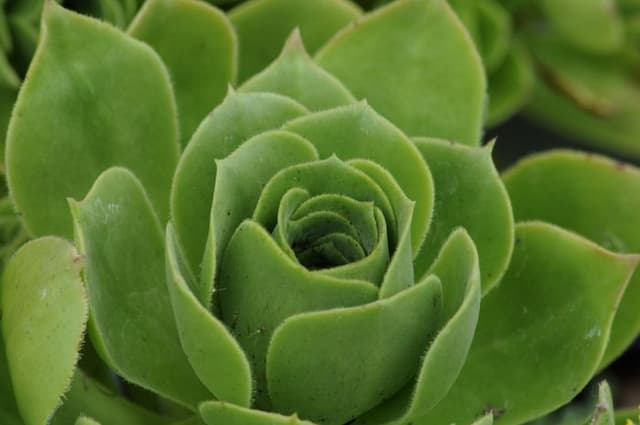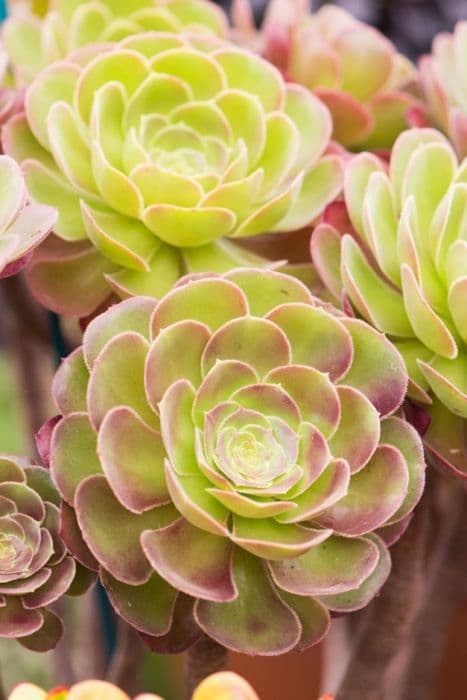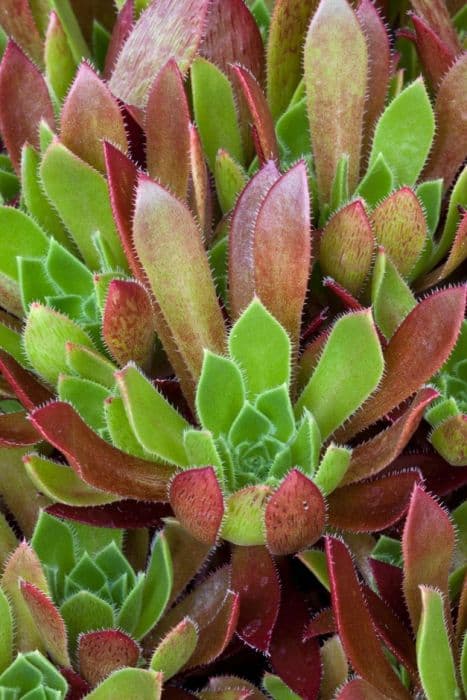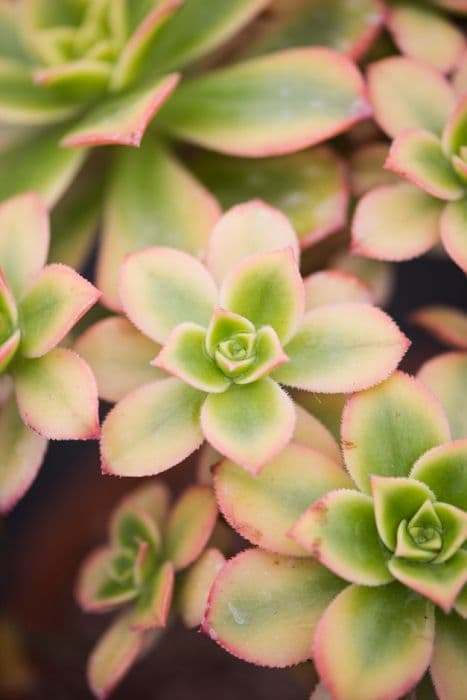Cobweb Houseleek Sempervivum arachnoideum var. bryoides











ABOUT
Sempervivum arachnoideum var. bryoides, commonly known as the cobweb houseleek, is a visually striking succulent plant. It features a rosette shape, which is typical of the species, with clusters of fleshy, green leaves. The leaves are tightly packed, forming a compact structure that appears sculptural in nature. The most distinctive characteristic of the cobweb houseleek is the fine, white, web-like filaments that stretch over the surface of the rosettes, giving the plant its "cobwebbed" appearance. These filaments are particularly pronounced at the tips of the leaves, creating a unique visual effect that somewhat resembles a spider's web. The leaves themselves have a touch of redness at the tips, providing a subtle contrast to the green foliage and white webbing. This adds to the plant's charm and makes it a favorite among succulent enthusiasts for rock gardens, containers, and as ground cover in suitable climates. The cobweb houseleek's ability to form dense mats of rosettes adds to its appeal, offering a textured, verdant spread in gardens. Its appearance can vary slightly with the seasons, with colors becoming more intense during the cooler months. The cobweb houseleek is not only admired for its beauty but also for its hardiness and ability to thrive in various conditions with minimal care.
About this plant
 Names
NamesFamily
Crassulaceae
Synonyms
Cobweb Houseleek, Cobweb Hen and Chick, Spider Web Hens and Chicks
Common names
Sempervivum bryoides, Sempervivum arachnoideum subsp. tomentosum.
 Toxicity
ToxicityTo humans
Cobweb houseleek (Sempervivum arachnoideum var. bryoides) is not known to be toxic to humans. There are no known toxic effects reported from ingesting this plant, and it is generally considered safe. However, as with any non-edible plant, consuming it is not recommended and could cause digestive upset or allergic reactions in sensitive individuals.
To pets
Cobweb houseleek is not known to be toxic to pets. It is generally considered safe for dogs, cats, and other animals. There are no significant symptoms of poisoning associated with this plant, as it is not known to contain any toxic substances. Pets ingesting this plant may experience mild gastrointestinal upset, but severe toxicity is unlikely.
 Characteristics
CharacteristicsLife cycle
Perennials
Foliage type
Evergreen
Color of leaves
Green
Flower color
Pink
Height
0.5 feet (15 cm)
Spread
1 foot (30 cm)
Plant type
Succulent
Hardiness zones
5
Native area
Europe
Benefits
 General Benefits
General Benefits- Easy to care for: Sempervivum arachnoideum var. bryoides, commonly known as Cobweb Houseleek, is a low-maintenance plant that does not require frequent watering or complex care routines.
- Drought resistant: It is adapted to survive in dry conditions, storing water in its leaves to endure periods without rain.
- Cold hardy: This variety can survive in cold temperatures, making it suitable for outdoor gardens in various climates.
- Propagation: It propagates easily, producing offsets that can be separated and replanted to expand your garden or share with others.
- Aesthetic appeal: The plant's unique cobweb-covered rosettes add visual interest and texture to rock gardens, green roofs, or container arrangements.
- Environmental resilience: It is resistant to pests and diseases, ensuring a hardy presence in the garden without the need for chemical treatments.
- Soil erosion control: The root system of this succulent helps to stabilize soil and prevent erosion on slopes and in rock gardens.
- Attracts pollinators: When in bloom, the flowers of Cobweb Houseleek can attract bees and other beneficial pollinators to the garden.
- Longevity: Being a perennial, it can live for several years, providing long-term structure and interest to the landscape.
- Decorative versatility: It can be used in a variety of garden designs, including alpine troughs, succulent wreaths, and as companion plants to other drought-tolerant species.
 Medical Properties
Medical Properties- Anti-inflammatory: Sempervivum arachnoideum, commonly known as cobweb houseleek, has been traditionally used to reduce inflammation when applied topically.
- Antiseptic: The plant's juice has antiseptic properties, which may help prevent infection in minor cuts and burns.
- Astringent: Cobweb houseleek may have astringent effects which could be beneficial in toning the skin and healing wounds.
- Emollient: It can be used as an emollient to soothe and soften the skin.
 Air-purifying Qualities
Air-purifying QualitiesThis plant is not specifically known for air purifying qualities.
 Other Uses
Other Uses- Sempervivum arachnoideum, commonly known as Cobweb houseleek, can be used as a living roof covering, providing insulation and reducing rainwater runoff.
- The dense rosettes of the Cobweb houseleek can be planted in crevices of stone walls, contributing to a rustic and natural aesthetic.
- This plant is sometimes used in miniature gardening, adding texture and interest to fairy gardens and small-scale landscapes.
- Cobweb houseleek can serve as a natural fire retardant when planted in fire-prone areas due to its high water content and succulent nature.
- As a groundcover in alpine and rock gardens, it helps prevent soil erosion on slopes and rough terrain.
- The peculiar webbed appearance of Cobweb houseleek makes it a popular choice for thematic Halloween gardens, adding a spooky touch to the decor.
- It can be used in container gardens to create low-maintenance, drought-tolerant arrangements that can survive with minimal attention.
- When planted as a border, the Cobweb houseleek delineates garden paths and segregates different garden sections with its unique form.
- The plant's ability to propagate easily from offsets means it can be shared among gardeners, fostering community and plant exchanges.
- Because it survives in harsh conditions, the Cobweb houseleek can be employed in education to teach about plant adaptations and survival strategies.
Interesting Facts
 Feng Shui
Feng ShuiThe Hen and Chicks plant is not used in Feng Shui practice.
 Plant Symbolism
Plant Symbolism- Perseverance and Survival: Sempervivum arachnoideum var. bryoides, commonly known as Cobweb Houseleek, can survive in harsh conditions and poor soil, symbolizing the ability to endure and thrive in difficult circumstances.
- Protection: Traditionally, Cobweb Houseleek was believed to ward off lightning and protect homes when planted on roofs, symbolizing safety and defense.
- Timelessness and Eternal Love: Since they are succulents that can live for many years and propagate easily, they represent long-lasting affection and the everlasting nature of love.
- Self-Reliance: Their ability to store water in their thick leaves allows them to be very independent plants, symbolizing self-sufficiency and autonomy.
- Renewal: Cobweb Houseleek regenerate themselves by constantly producing offspring, representing rebirth and new beginnings.
 Water
WaterThe Cobweb Hens and Chicks should be watered sparingly, as it is a drought-resistant succulent. Allow the soil to dry out completely between waterings. Typically watering once every 7-10 days during the active growing season, which is spring and summer, is sufficient, though this may vary depending on your climate and indoor conditions. When you do water, apply enough to soak the soil, which might be approximately a half to one gallon for a medium-sized pot every two weeks. In the dormant season, which is fall and winter, reduce the frequency of watering to once a month or less.
 Light
LightCobweb Hens and Chicks thrive in bright light and should be placed in a location where they can receive full to partial sunlight for at least six hours a day. An east or south-facing window is ideal when growing indoors, while an outdoor spot that provides some protection from the intense, midday sun will prevent scorching.
 Temperature
TemperatureCobweb Hens and Chicks prefer a temperature range of 65°F to 75°F during their growing season. They can endure temperatures as low as 20°F and as high as 90°F, but temperatures within the ideal range are best for thriving growth. Always protect the plant from frost, which could damage the leaves.
 Pruning
PruningCobweb Hens and Chicks require minimal pruning. Remove dead or damaged leaves to maintain the plant's appearance and promote healthy growth. This typically only needs to be done once or twice a year. The best time for pruning is early spring or just after flowering when the rosettes have finished their lifecycle.
 Cleaning
CleaningAs needed
 Soil
SoilCobweb houseleek thrives in well-draining soil with a mix of potting soil, perlite, and coarse sand, making a ratio of 1:1:1 ideal. Aim for a slightly acidic to neutral pH between 6.0 and 7.5 for optimal growth.
 Repotting
RepottingCobweb houseleek should be repotted every two to three years, or when it outgrows its container, to refresh the soil and prevent overcrowding of its offsets.
 Humidity & Misting
Humidity & MistingCobweb houseleek prefers a dry climate and is tolerant of low humidity levels, making it well-suited to arid conditions typically found in indoor environments.
 Suitable locations
Suitable locationsIndoor
Place in a sunny spot with good airflow.
Outdoor
Full sun to partial shade; well-draining spot.
Hardiness zone
3-8 USDA
 Life cycle
Life cycleSempervivum arachnoideum var. bryoides, commonly known as cobweb houseleek, begins its life cycle when seeds are dispersed and germinate in well-draining soil with enough sunlight. The seedlings develop a rosette of succulent leaves that are adapted to conserve water in their natural alpine or rocky habitats. As the plant matures, it produces offsets, or "chicks," which cluster around the parent "hen," allowing vegetative propagation. During the summer months, usually in the second or third year, it sends up a flowering stalk that may grow over a foot tall, bearing star-shaped flowers, typically red to pink in hue. After flowering, which is a signal of the last stage in the life of the individual rosette since it is monocarpic, the flowering rosette dies, leaving behind its offsets to continue the growth cycle. Over time, these offsets establish new colonies and the cycle repeats, ensuring the survival of the species.
 Propogation
PropogationPropogation time
Spring to early summer
The most popular method of propagating the plant known as Hen and Chicks (Sempervivum arachnoideum var. bryoides) is through division, specifically by separating the offsets. These offspring, often dubbed “chicks,” readily form at the base of the “hen,” or the mother plant, and are connected by a stolon. During the spring or early summer, gently pull these chicks away from the mother plant, ensuring each has some roots attached. After separating them, allow the offsets to air dry for a couple of days to form a callous over the cuts, which helps prevent rotting. Then plant the offsets in well-draining soil, watering sparingly until they establish. This method is highly effective as it closely mimics the natural means by which the plant propagates and typically results in a high success rate.









